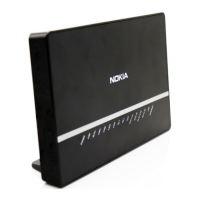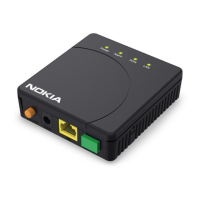Ethernet Connection Fault Management
170
"FD 100/320Gbps NT and FX NT IHub System
Basics, Management and OAM Guide"
3HH-11982-AAAA-TQZZA Issue: 10
• 4 (VPN ID) - Hex value as described in RFC 2685, Virtual Private Networks
Identifier
• 32 (icc-format) - Exactly 13 characters from the ITU-T recommendation T.50.
Maintenance Domain Level (MD Level)/Maintenance Entity Group Level (MEG
Level) is the numerical value (0-7) representing the width of the domain. The wider
the domain, higher the numerical value, the farther the ETH-CFM packets can travel.
It is important to understand that the level establishes the processing boundary for
the packets. Strict rules control the flow of ETHCFM packets and are used to ensure
proper handling, forwarding, processing and dropping of these packets. To keep it
simple ETH-CFM packets with higher numerical level values will flow through MEPs
on MIPs on SAPs configured with lower level values. This allows the operator to
implement different areas of responsibility and nest domains within each other.
Maintenance association (MA) includes a set of MEPs, each configured with the
same MA-ID and MD level used verify the integrity of a single service instance.
Maintenance Endpoint (MEP)/MEG Endpoint (MEP) are the workhorses of
ETH-CFM. A MEP is the unique identification within the association (0-8191). Each
MEP is uniquely identified by the MA-ID, MEPID tuple. This management entity is
responsible for initiating, processing and terminating ETH-CFM functions, following
the nesting rules. MEPs form the boundaries which prevent the ETH-CFM packets
from flowing beyond the specific scope of responsibility. A MEP has direction, up or
down. Each indicates the directions packets will be generated; UP toward the switch
fabric, down toward the SAP away from the fabric. Each MEP has an active and
passive side. Packets that enter the active point of the MEP will be compared to the
existing level and processed accordingly. Packets that enter the passive side of the
MEP are passed transparently through the MEP. Each MEP contained within the
same maintenance association and with the same level (MA-ID) represents points
within a single service. MEP creation on a SAP is allowed only for Ethernet ports with
NULL, q-tags encapsulations. MEPs may also be created on SDP bindings.
Maintenance Intermediate Point (MIP)/MEG Intermediate Point (MIP) are
management entities between the terminating MEPs along the service path. These
provide insight into the service path connecting the MEPs. MIPs only respond to
Loopback Messages (LBM) and Linktrace Messages (LTM). All other CFM functions
are transparent to these entities. Only one MIP is allowed per SAP or SDP. The
creation of the MIPs can be done when the lower level domain is created (explicit) or
manually (default). This is controlled by the use of the mhf-creation mode within the
association under the bridge-identifier. MIP creation is supported on a SAP and SDP,
not including Mesh SDP bindings. By default, no MIPs are created.
Note — When a VID is used as the short MA name, 802.1ag
will not support VLAN translation because the MA-ID must
match all the MEPs. The default format for a short MA name is
an integer. Integer value 0 means the MA is not attached to a
VID.

